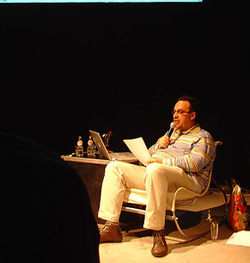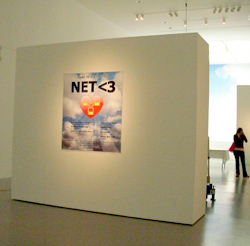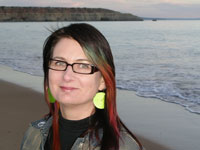Outline of Meetings
From Collectivate Course Wikis
Outline of Meetings
Death, Data, & Desire is comprised of two co-taught classes, offered in studio lab and seminar format, which in tandem introduce an experimental, playful setting and enough time to get exposed to art, learn necessary production skills through knowledge swap sessions, read relevant theory, and produce collaborative critical art projects. Syllabi are created individually for each student (see research pages).
Week 1: Introduction
- Production, discussion, presentations, preparation of the exhibition, and individual research conferences alternate.
Each student developed an individual reading program in consultation with the instructors.
Tues, Jan 17
Course philosophy and motivation Identify skills, interests, needs Identify research themes Connect to/meet with others in class Thurs, Jan 19
Discussion: process documents and project milestones What is research in an art context? Set up project pages on the course wiki.
Week 2
Tues, Jan 24
Thurs, Jan 26
Week 3: Initial Interests, Thesis, Writing
Tues:
Present art projects/research that illustrates your interests Intro: Writing a thesis
Thurs:
Comments on writing; see Resources
Create weekly research entries documenting your ongoing dialogical work with the your individual readings Group: Report in on your research (1-2:15pm)
Planning of individual meetings and group gatherings
Nick: 2:45pm-3:15pm, Brian: 3:15pm-4pm, Al: 4-4:45pm
- Sign up for:
- Assignment until Tuesday: Set up research pages on your personal wiki page,
enter your individual research schedule, write first response entry
Week 4: Individual Meetings, Skill Workshop, Discussion: Death of the Artist
Tues:
Individual Conferences
David H.: 1-1:30pm
SVN: 1:30pm-2pm
Loren: 2-3pm
Skill Workshop: CSS by David Hohusen 3-5pm, Rm 244 Resource Files
Lecture by Dr. Judith Rodenbeck. The Open Work: Participatory Art Since Silence
Judith Rodenbeck at 7pm, DMS 235
listen to lecture approx. 1 hour
Download Class Lecture Slides (pdf)
Download Lecture Slides from Public Lecture(pdf)
In the introduction to his 2002 book, Relational Aesthetics, the curator Nicolas Bourriaud writes that currently, "the liveliest factor that is played out on the chessboard of art has to do with interactive, user-friendly and relational concepts." Neither revival nor comeback, relational aesthetics, for Bourriaud, is the correct vanguardist response to a world saturated by mass communications. Part of the newness had to do, in Bourriaud's account, with asking what kind of art was possible after the doldrums of the 1980s, when the hegemony of "spectacle" seemed assured (via the alleged failures of May 1968), after institutional critique seemed to have run its course, and after any socially-engaged avant-garde had exhausted itself and the political patience of its adherents-and even, perhaps, the conditions of its possibility. "How are these apparently elusive works to be decoded, be they process-related or behavioral by ceasing to take shelter behind the sixties art history?" (Bourriaud, 7) Yet this unwillingness to examine relational aesthetics with an eye on history is a defensive maneuver. As such it is one that needs to be taken on. This talk is an historical presentation addressed to some of the parameters under which the "interactive, user-friendly and relational" were actively explored-and critiqued--in key works of the 1950s and early 1960s.
About Dr. Judith Rodenbeck: BA, Yale University. BFA, Massachusetts College of Art. MA, MPhil, PhD, Columbia University. Special interests in art since 1945 and its compositional strategies; intersections between modernist literature, philosophy, and the visual arts. Co-author and co-curator with Benjamin Buchloh of Experiments in the Everyday: Allan Kaprow and Robert Watts--events, objects, documents; contributor to catalogues for Work Ethic and Inside the Visible; author of articles for Grey Room, The Art Book, Documents, and P-Form. Recipient of fellowships, including Henry Luce Foundation/ACLS Fellowship in American Art and Columbia University Mellon Fellowship for Art History.
Thurs:
Discussion (1-2pm): Are we artists, curatos, programmers, or writers or what?
Read: iDC Discussion
Work on Research Page Rm. 244.
Preparation for meeting with UB Gallery curator Sandra Firmin: all present our projects to be on display/to be performed by all of you mid- to late April in the UB Gallery.
Week 5: Meet the curator
Tues:
Sandra Firmin comes to class to hear a brief description of your project presentation. She will talk about the exhibition, performance, workshop plans for the UB Gallery in Apil. Be prepared to give fairly outline of your event or installation or lecture and think about technical needs. This includes details like numbers of chairs and tables or alike. This is followed by your research presentations.
Thurs
- Development plan is due.
Week 6: Research Presentations, Production Plan
Tues:
- Research Presentation Al Larsen
Thurs:
- Organizational (Exhibition): Al Larsen- information liason, Jon Burow- installation liason
- Research Presentation David Hohusen
- Brief presentation of production plan by each group
Week 7: Skill Share Workshops, Exhibition Preparation
Tues:
Skill Share Workshops
- PHP/MySQL - Tom
resources E-mail weters19@gmail.com
- Flash Action Scripting - Jon
- Discussion about exhibition
Thurs
- Research Presentation Brian Diesel
Week 8: Discussion on Relational Aesthetic & Production
Tues
Discussion: Keywords: Post net-art and perception, wireless aesthetics, dispersed experience What is new media aesthetics and relational aesthetics? Who is doing this stuff? Is there a public for it or how do we produce spaces of reception?
Thurs:
Production Day
Week 9: Spring Recess
Spring Recess
Week 10: Prototype Presentations
Tues, Mar 21
No class (trip to NYC) Thurs, Mar 23
- Prototype Presentation
Week 11
Tues, Mar 28
- Prototype Presentation (40 min each)
- Al Larsen
Thurs, Mar 30
- Prototype Presentation (40 min each)
- SNV
Week 12: Prototype Presentation
Tues, April 04
Prototype presentation - Loren
Thurs, April 06
Gallery preparation
Trip to NYC: Whitney Biennial, Manovich Talk
Fri, April 07
Trip to NYC. Whitney Biennial and Lev Manovich talk
A talk by artist Lev Manovich will be held in conjunction with the exhibition at 7 p.m. on Friday, April 7 in Room 213, adjacent to the gallery. It is free and open to the public.
Week 13: Two-Day UB Gallery Program "Net<3"
Mon, April 10
- UB Gallery Show final setup 12-5pm (gallery open for visitors)
- UB Gallery Show opening 5-9pm
Tues, April 11
- UB Gallery Show work on display 12-9pm
- UB Gallery Show presentations 5-9pm
Wed, April 12
- UB Gallery Show takedown 12-5pm
Thurs, April 13
- Research Presentation Loren Sonnenberg
Video and Image Log of Net<3
Week 14: Individual Conferences
Tues, April 18
- Nick
- Al
- Brian
- SNV
- Dave
Amanda MacDonald Crowley Lecture: Collaboration and curating new media art
Wed, April 19
DMS, Room 235
6pm
Amanda McDonald Crowley (Executive Director of Eyebeam art and technology center in New York, NYC)
listen to Crowley lecture
Title: Collaboration and curating new media art
Abstract: Does collaboration in curatorial practice constitute compromise, act as a catalyst, or infer complexity?
There has been much debate in recent times around the benefits or otherwise of collaboration in curatorial practice, particularly as it concerns so-called new media art practice. Does collaboration necessitate compromise? Does it mirror the practice of artists working in this field, or does it mean that curators are objurgating responsibility for their authorial role in the making of exhibitions and events, opting, instead for a role as a collaborator in the artistic endeavour? Do new media curators want to be artists? Are new media practitioners even artists or are they, in line with rhetoric surrounding the recently popularised creative industries, or cultural industries, merely creatives as part of content production teams?
Thurs, April 20
Week 15: Finish Projects, Critique with students from UC Santa Cruz
Tues, April 25
Finish Projects, Engage Wider Public Public Online and Off, Finish Last Research Entries
Notes:
Reflections on Al's performance: Glitch Aesthetics
The unreliable fleeting nature of the Internet conditions the art created for it. The fact that things did not work out made up the strength of the piece. Failure as window of possibility. The screen exerts its power. We are so used to screen-based worlds and it is a relieve to see this embodied focal point pulling participants away from the screen. The performance becomes a dialogue between the computational surface and the person.
Questions:
How would it change the performance if parts of the web interaction would be prerecorded as screen video? How can the drama of the Internet, with its possible, incalculable shutdowns be heightened? What did the social game focus on? Where did it lead people? The emotional, spontaneous interaction with the interface of the audiovisual blog is highlighted.
The performer, unlike the powerpoint lecturer, disrupts the peace of the pacified armchair passenger, one-to-one with the screen. Here, the performer is happening, intermingling screen realities with hot bodies. GHe creates an uncomfortable closeness in the black box space. He makes the participants aware how they interact with media.
Performance props: A small bag of things that you are choosing to take on a trip. The slow motion of the performer as opposed to the nervous, rapid flickering speeding mouse on screen. Should remote performers, distributed, controlling the performer from afar become part of the piece?
The performer loosens up the people in the room: "Cakes and jam!," animations, sms from your cell phone to the screen. The tension between documentation of the performance and the performance itself blurs the borderline between the artwork on the screen and the embodied artist. The performer breaks open the audience grid to activate open social behavior. Blogs move "users" in very predesigned paths.
"One day I broke the CSS of the blog and all elements of the blog were mashed up. I thought- yeah, that's it. I'd like to play with these formats." Blogs merely allow us to inflict styles. It takes the technically informed user to randomize these preset patterns.
Class Suggestion:
Use of ultra small projectors. Projecting onto bodies. Cellphones project a keyboard, letting you type. Project your cellphone.
Art and research. Understanding your process and outcomes through process documents. Reflect on your process. "Art practice qualifies as research when its purpose is to broaden our knowledge and understanding through an original investigation." What does it mean to do research?
Theory and production/practice don't marry like bread and jam. Their convergence is a process that needs to be learned. Once established the artist becomes a participant-observer. He reads and works. His production experience informs the way he grasps the texts. Snippets from essays may inform and inspire production. The act of making becomes the process of taking part in a conversation: discourse.
What is a discoursive intervention?
You enter a room where people are talking. They have a conversation and you first listen in order to then contribute in a meaningful way: a discursive intervention.
Thurs, April 27
Critique of projects by students from UC Santa Cruz




